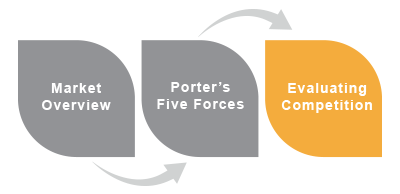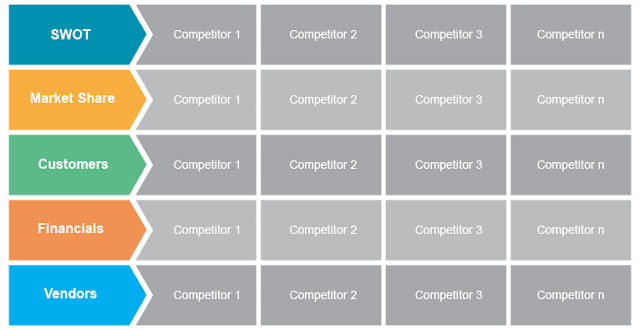In the last article of Key Business Concepts 101, we started our discussion of performing competitive analysis, and focused on the very well-known Porter’s Five Forces. It is a key framework which can provide businesses with very valuable insight into their industry, market, and competition. In this article, we pick up the pace and go into more details regarding competitive analysis.
 |
| Figure 1- Methods for Strategic Business Planning |
Market Overview
As mentioned in our previous article, a good place to start competitive analysis is to review industry market reports. Having done that and researching the target market, you have collected information about market size, key players, products, services, etc. You have also considered the industry you are getting into, its current trends, where it is going, and other characteristics.
Porter’s Five Forces
You have also applied Porter’s Five Forces framework and gathered and analysed relevant data. So, you have considered current market competition, possible new entrants, product/service substitutes, and the bargaining powers of both your suppliers and your customers.
A closer look at your competitors
Although you have already considered current competitors as part of the analysis performed using Porter’s Five Forces framework, performing a more detailed analysis of competition can provide you with valuable information that can enable you to create a more robust strategic plan.
 |
| Figure 2 Competitive Analysis |
Knowing more about your competitors can help you plan your business in several ways. It can help you establish a reference and a starting point to determine the main aspects of your business. Before offering certain products or services to your market, you need to know what products and services are there already. The comparison between what is there already and what you want to offer can help you refine your product plans to bring better products, update prices, and improve your pricing strategy. It will also enable you to better plan your distribution channel and come up with the proper marketing and promotion activities you need to market your products and services. It is also a key input into your positioning strategy as you will see in the STP section below.
Which competitors to analyse?
There are usually many competitors, whether direct or indirect, so a good approach is to choose a few of them and try to mix them. For example, while you should focus more on direct competitors, you should also consider indirect competition as discussed in the Porter’s Five Forces section. You should also look at competitors who are, for example, multinational/international companies, local, regional, and of varying sizes and market share. Diversifying your competitor analysis will make it richer so that you look at the market from various angles.
What to look for?
Competitive analysis entails defining your main competitors and collecting as much information about them as possible. This includes their current market share, product and service details, pricing scheme, distribution strategy, marketing initiatives, financial standings, etc. The more you know about your competitors, the better you position your business to compete in the market and establish a solid foothold to gain an acceptable market share. The information can serve you in benchmarking your business and establishing a baseline to evaluate your business performance.
Some key aspects that you should consider about competition are:
- SWOT Analysis: Perform SWOT analysis of your competitors and compare that to your own SWOT analysis.
- Market Share: Knowing your competitors’ market share is essential to your competitive analysis.
- Customers: Find out all you can about their customers such as demographics, segments, buying habits, etc.
- Financials: Find out as much as possible about your competitors’ financial standing, cost structure, and revenue streams.
- Vendors: Try to find out about their suppliers and where they get their base products or raw materials.
Further analysis
The topic of competitive analysis is vast, but remember that at this point, you are looking at it from a strategic perspective, which is a relatively higher level. You will revisit this area in more detail when you perform detailed market planning and create your marketing plan. We will cover market planning as part of our Key Business Concepts 101 series. However, for a detailed competitive analysis to use then, consider our next article as well, Key Business Concepts 101: Competitive Analysis Part II.



No comments:
Post a Comment